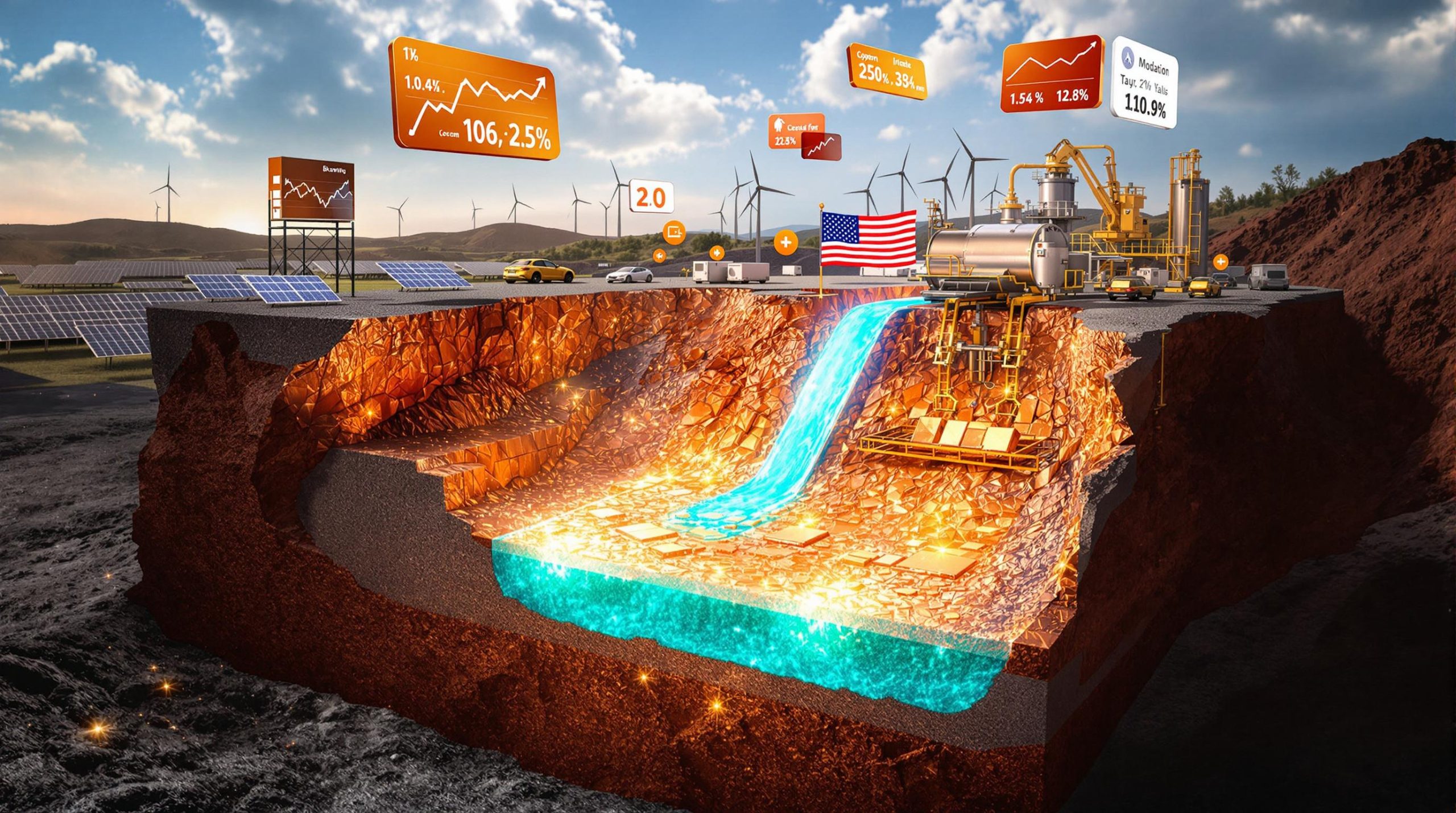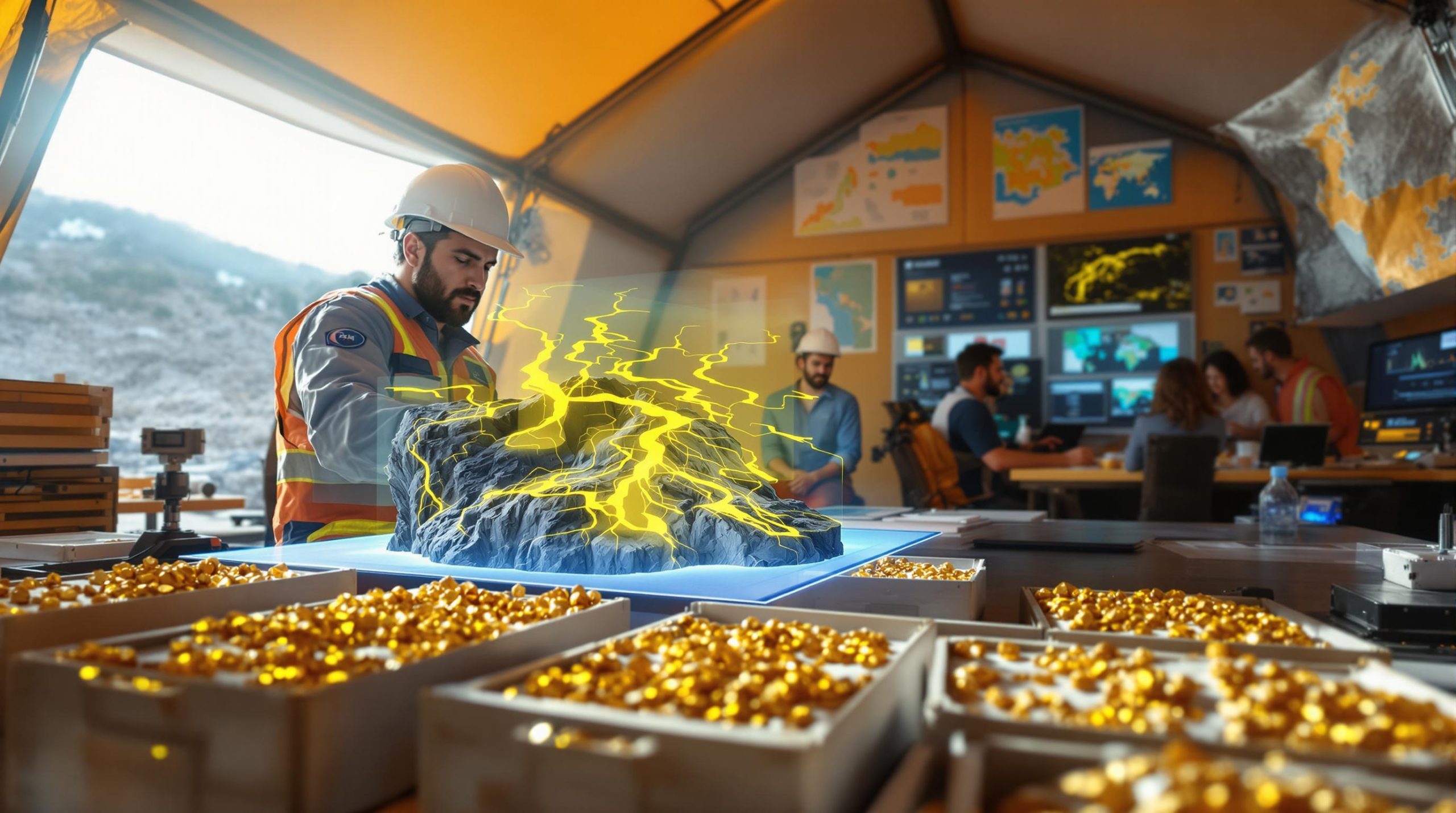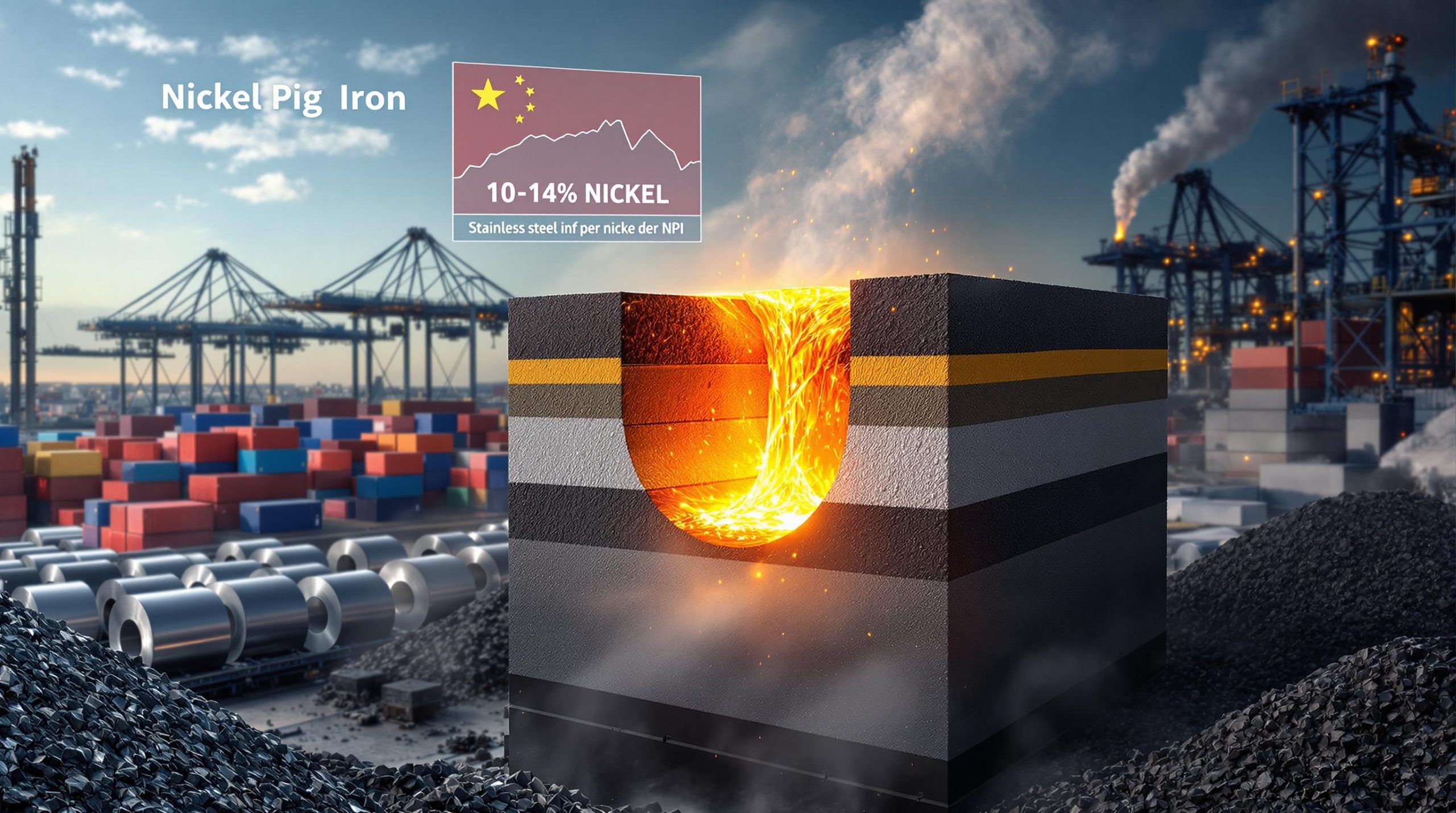Understanding the Copper Supply-Demand Imbalance
The United States faces a perplexing copper supply-demand paradox. Despite being home to substantial copper reserves and resources, the country remains heavily dependent on imports to satisfy its domestic demand. This counterintuitive situation stems from a complex interplay of infrastructure limitations, processing challenges, and global market dynamics that have created a significant gap between America's potential and actual copper production capabilities.
The US Copper Paradox: Resource Rich Yet Import Dependent
The United States possesses abundant copper resources within its borders, yet consistently runs a substantial supply-demand deficit. As John Slaven, CEO of Jetti Resources explains, "The US has a supply-demand deficit, which is counter-intuitive, given how much copper resource there is in the US. We've got resources in the ground and we're actually generating a lot of copper scrap."
This disconnect exists primarily because many domestic deposits consist of lower-grade primary sulfide ores or complex copper deposits that are expensive or challenging to process using traditional methods. While the minerals remain in American soil, the economic and technological barriers to recovering them have created an artificial scarcity in domestic production. Understanding the global copper supply forecast provides context for this unusual situation.
The Processing Capacity Challenge
A critical factor exacerbating the copper supply gap is the underutilization of existing processing infrastructure. Current data reveals that US SX-EW (solvent extraction-electrowinning) capacity stands at approximately 800,000 tonnes per year, yet only 430,000 tonnes are actually being produced—representing just over 50% utilization of available capacity.
This underutilization represents a significant missed opportunity for domestic copper production. The existing infrastructure could theoretically produce much more copper without requiring additional capital investment in new facilities, if only the technological barriers to processing certain ore types could be overcome.
Export Dynamics and Processing Limitations
The United States frequently finds itself in the peculiar position of mining copper concentrates domestically only to export them for processing overseas—often to China—before reimporting the finished copper products. This circuitous supply chain exists primarily because:
- Insufficient domestic smelting and refining capacity forces export of concentrates
- Traditional processing methods struggle with America's predominantly low-grade and complex ores
- The economics of domestic processing haven't justified the capital investment needed for expansion
This creates a scenario where American copper essentially leaves the country as a raw material and returns as a value-added product, with the economic benefits of that value addition accruing to other nations rather than supporting domestic manufacturing and employment.
How Significant is the US Copper Supply Gap?
The copper supply gap in the United States represents not just a statistical anomaly but a strategic vulnerability with significant economic implications. Understanding the magnitude of this deficit and the untapped potential that exists within current infrastructure provides context for evaluating potential solutions.
Quantifying America's Copper Deficit
The scale of America's copper dependency is substantial and could be dramatically reduced through better utilization of existing infrastructure. According to industry experts, the United States could shrink its copper deficit by as much as 60% simply by fully utilizing the installed SX-EW capacity that already exists within the country.
This represents an extraordinary opportunity to increase domestic production without the lengthy timelines typically associated with developing new mining operations. As John Slaven notes, "It is a meaningful number and it's available virtually immediately, with no permitting, and with very little capital expenditure. It is the ultimate no-brainer."
Strategic Implications of Import Dependency
America's reliance on imported copper carries several strategic risks:
- Supply chain vulnerability to international disruptions
- Price volatility exposure from global market fluctuations
- National security concerns regarding critical infrastructure materials
- Economic opportunity costs from foregone domestic production
These factors make reducing the copper supply gap not merely an economic opportunity but a matter of strategic importance for American industrial policy and security planning. The rising copper demand globally only increases the urgency of addressing this gap.
The Production Paradox: Untapped Potential
What makes the copper supply gap particularly frustrating is that the solution lies largely within existing resources and infrastructure. The country possesses:
- Substantial untapped copper resources in the ground
- Existing SX-EW processing facilities operating below capacity
- Mining operations already producing copper-bearing materials
- Technical solutions that could unlock these stranded assets
The primary barriers are not geological or infrastructural, but technological and economic—precisely the areas where innovations in processing technology could make a substantial difference.
How Can Leaching Technology Transform Copper Production?
Advanced leaching technology represents one of the most promising pathways to bridging the copper supply gap by making previously uneconomic resources viable. These innovations specifically target the primary sulfide ores that have historically been challenging to process through conventional leaching methods.
Breakthrough Innovations in Copper Recovery
Traditional leaching methods have been effective for oxide and secondary sulfide ores but struggle with primary sulfide resources that make up a significant portion of America's copper endowment. New catalytic leaching technologies are changing this equation by dramatically improving recovery rates from these previously "stranded" resources.
The science behind these advancements involves catalysts that accelerate the natural leaching process, enabling copper to be dissolved and recovered from ores that would otherwise require energy-intensive concentration and smelting. This represents a fundamental shift in how certain copper resources can be processed. Many copper investment strategies now factor in these technological breakthroughs.
Dramatic Improvements in Recovery Rates
The impact of advanced leaching technologies on recovery rates is substantial. According to industry data:
- Without advanced technology: Only 10-15% copper recovery from run-of-mine primary sulfide ore
- With advanced leaching: Recovery rates increase to approximately 45%
- With crushing optimization: Recovery rates can reach up to 60%
These improvements transform resources that were previously considered uneconomic into viable production opportunities. The ability to extract three to six times more copper from the same material fundamentally changes the economics of many existing operations and dormant resources.
Economic Advantages of Implementation
Perhaps the most compelling aspect of advanced leaching technology is its favorable economic profile compared to traditional copper processing methods:
- Low capital requirements: Implementation costs under $10 million, described by industry experts as "a rounding error in the equation"
- Competitive operating costs: Incremental operating costs of $1.00-1.50 per pound of copper produced
- Rapid deployment: Can be implemented quickly without extensive permitting processes
This combination of low capital intensity, reasonable operating costs, and quick deployment creates a compelling business case for mining companies looking to increase production from existing assets or develop new resources that would be uneconomic using conventional methods.
Leveraging Existing Infrastructure
One of the most significant advantages of advanced leaching technology is its ability to utilize existing SX-EW infrastructure that is currently underutilized in the United States. With 430,000 tonnes of annual production against an installed capacity of 800,000 tonnes, there's substantial room for increased output without major capital investment in new processing facilities.
As industry expert John Slaven notes, "This is copper that can be produced tomorrow, if somebody chooses to." The ability to quickly increase production with minimal permitting requirements and capital expenditure creates an opportunity for rapid impact on domestic copper supply.
What Environmental Benefits Does Modern Leaching Offer?
Beyond the economic and strategic advantages, advanced leaching technologies offer significant environmental benefits compared to traditional copper processing methods. These sustainability advantages make them increasingly attractive in an era of heightened environmental awareness and stricter regulatory requirements.
Reduced Environmental Footprint
Modern leaching technologies generally create a lighter environmental footprint than conventional processing methods in several key areas:
- Lower energy consumption: Eliminating the need for energy-intensive grinding, flotation, and smelting processes
- Reduced emissions: Fewer greenhouse gases and other air pollutants without high-temperature smelting
- Smaller physical footprint: Less land disturbance compared to large concentrator facilities
- Minimized waste generation: More targeted extraction creating less tailings and waste material
These advantages can be particularly significant for projects in environmentally sensitive areas or regions with strict emissions standards. The elimination of smelting, in particular, removes a major source of environmental impact associated with traditional copper production.
Water Conservation Advantages
Water usage represents one of the most significant environmental advantages of advanced leaching technologies, especially in the arid regions where many copper mines operate:
- Reduced overall water consumption: Advanced leaching processes require less water per pound of copper produced
- Closed-loop water systems: Many SX-EW operations recycle water within the plant rather than discharging it
- Reduced freshwater requirements: Process water can often be of lower quality than that required for conventional processing
For copper projects in water-scarce regions of the American West, these water advantages can be critical not only for environmental compliance but also for securing the social license to operate from local communities concerned about water resources. According to a McKinsey study on the copper supply gap, water conservation is becoming increasingly critical for new projects.
Comparison with Traditional Processing Methods
When compared directly with conventional concentration and smelting, the environmental advantages of advanced leaching become even more apparent:
| Environmental Factor | Traditional Processing | Advanced Leaching |
|---|---|---|
| Energy Intensity | High (grinding, flotation, smelting) | Moderate to Low |
| Water Usage | High (flotation requires significant water) | Moderate (with recycling) |
| Emissions Profile | High (particularly from smelting) | Low (no high-temperature processes) |
| Land Disturbance | Large (concentrator facilities, tailings) | Smaller (leach pads, SX-EW plant) |
| Waste Generation | High (tailings volume) | Lower (more targeted extraction) |
These environmental advantages align with the growing emphasis on ESG (Environmental, Social, and Governance) performance in the mining industry, potentially making advanced leaching projects more attractive to investors and stakeholders focused on sustainability metrics.
What Challenges Prevent Wider Technology Adoption?
Despite the compelling economic and environmental case for advanced leaching technologies, their adoption across the copper industry has been slower than might be expected. Several key barriers have prevented more widespread implementation, particularly among major mining companies.
Risk Aversion in Major Mining Companies
Large mining companies have historically been cautious about adopting new technologies, particularly in their core production processes. This risk aversion stems from several factors:
- Financial consequences of failure: The costs of unsuccessful technology implementation can be substantial
- Reputational risks: High-profile failures can damage corporate credibility
- Operational disruption concerns: Fear that new technologies might disrupt existing production
- Accountability issues: Decision-makers worry about being held responsible for unsuccessful innovations
As John Slaven observes, "What the mining companies are concerned about is spending time and money on something that doesn't work." This concern is amplified in large organizations where decision-making processes are complex and the consequences of failure can affect multiple stakeholders.
Internal Technology Development Conflicts
Many major mining companies have developed their own internal R&D programs focused on similar leaching technologies. This creates a potential conflict when evaluating externally developed solutions:
- NIH (Not Invented Here) syndrome: Preference for internally developed solutions
- Competing priorities: Internal technology groups advocating for their own developments
- Resource allocation conflicts: Competition for testing resources and implementation budgets
- Career advancement incentives: Internal champions promoting their own projects
Industry insiders note that companies including Freeport-McMoRan, Anglo American, and Rio Tinto have been developing their own technologies, though none have yet achieved the commercial validation that would drive widespread adoption.
Different Adoption Patterns: Majors vs. Juniors
Interestingly, smaller mining companies have shown greater agility in adopting advanced leaching technologies. According to John Slaven, "We are now working with smaller miners too. They are able to move quickly, and you don't have the same issue with the internal technology groups wanting to promote their internal technology developments."
This creates a bifurcated adoption pattern where:
- Major miners: Slower adoption, more extensive testing, preference for internal solutions
- Junior miners: Faster decision-making, greater openness to external technologies, fewer institutional barriers
This pattern suggests that technology diffusion may follow a bottom-up rather than top-down path in the copper industry, with successful implementations at smaller operations eventually convincing larger players of the technology's viability. Recent copper price insights suggest that economic pressure may accelerate this adoption.
Technical Implementation Challenges
Beyond organizational resistance, legitimate technical challenges also affect adoption rates:
- Site-specific adaptations: Every ore body is different, requiring customization
- Integration with existing systems: Connecting new processes with legacy infrastructure
- Scale-up considerations: Ensuring laboratory success translates to commercial operations
- Performance validation: Establishing credible metrics for success and measurement protocols
Addressing these technical challenges requires methodical testing and validation, often involving staged implementation beginning with smaller pilot projects before full-scale deployment.
How Could Policy Support Accelerate Copper Production?
Government policy could play a pivotal role in accelerating the adoption of advanced copper processing technologies and expanding domestic production. Strategic initiatives, financial incentives, and risk-sharing mechanisms could help overcome many of the barriers that currently limit technology implementation.
Strategic Initiatives to Boost Domestic Production
Several policy approaches could help close the copper supply gap and strengthen America's position in this critical mineral:
- Financial incentives for technology adoption: Tax credits, grants, or accelerated depreciation for investments in advanced processing technologies
- Differential treatment of cathode vs. concentrate: Policies that favor domestic copper cathode production over raw concentrate exports
- Permitting streamlining: Expedited approvals for projects that increase domestic copper production
- Research and development support: Government funding for next-generation extraction technologies
These approaches would align with broader strategic objectives of reducing import dependency and strengthening domestic supply chains for critical minerals.
Tariff Considerations and Market Signals
Import tariffs represent one potential policy lever that could influence the economics of domestic copper production. As John Slaven notes, "What the [import] tariffs would have done is increase the financial benefit of producing cathode over concentrate… Suddenly, leaching becomes a much more attractive avenue."
By creating economic incentives that favor domestic production of finished copper products rather than exporting concentrates for overseas processing, tariffs could accelerate the adoption of technologies that enable end-to-end domestic production.
Risk-Sharing Mechanisms and Public-Private Partnerships
One of the most promising policy approaches involves government participation in absorbing the early-stage risk of technology implementation. Potential models include:
- Government-backed performance guarantees: Reducing financial risk for early adopters
- Public-private demonstration projects: Sharing the costs of initial commercial-scale deployments
- Strategic copper stockpiling: Government purchases of copper from innovative projects
The concept of strategic stockpiling is particularly interesting, as it addresses both supply security and technology adoption objectives. As one industry expert suggests, "Rather than having it sitting on the ground at 0.2% in a rock, recover it and put it in a strategic [stockpile]… The government takes the risk on recovering it economically, and the miners get paid for their copper now."
National Security and Critical Mineral Considerations
Copper's importance to energy transition, defense applications, and critical infrastructure makes it increasingly relevant to national security planning. Policy frameworks that explicitly recognize copper as a critical mineral could unlock additional support mechanisms:
- Defense Production Act authorities: Prioritization and funding for domestic production
- Critical mineral stockpiling: Inclusion in strategic material reserves
- Supply chain resilience programs: Integration with broader critical mineral strategies
- Investment screening protections: Safeguards for domestic copper assets
These approaches would position copper alongside other materials deemed essential for national and economic security, potentially unlocking additional policy support. Interest in copper and uranium investments has grown as both minerals become increasingly critical for energy transition.
What Results Have Been Demonstrated in Commercial Applications?
Moving beyond theoretical potential, advanced leaching technologies have begun demonstrating their capabilities in commercial applications. These real-world deployments provide critical validation of the technology's economic and technical viability.
Pinto Valley Deployment Case Study
One of the most significant commercial implementations of advanced leaching technology has been at Capstone Copper's Pinto Valley operation. This deployment has provided valuable insights into:
- Implementation process: The practical steps required to integrate new leaching technology
- Performance metrics: Actual recovery rates achieved in commercial operation
- Operational learnings: Adaptations and optimizations developed during implementation
- Economic outcomes: Financial performance compared to projected returns
While specific production figures haven't been publicly disclosed, industry sources indicate that the technology has delivered meaningful improvements in recovery rates consistent with the ranges described earlier (45-60% compared to 10-15% with conventional methods).
Commercial Expansion and Industry Adoption
The technology appears to be gaining commercial momentum. According to John Slaven, "We are currently very, very close to concluding an agreement with two [major miners], but we are now working with smaller miners too." This suggests that the technology is moving from early adoption into a broader implementation phase.
The involvement of both major and junior miners indicates growing acceptance across different segments of the industry, which typically precedes more widespread adoption. The willingness of major miners to consider the technology suggests that the demonstration results have been compelling enough to overcome some of the institutional resistance described earlier.
Performance Across Different Ore Types
An important aspect of commercial validation has been demonstrating
Want to Capitalise on the Next Major Copper Discovery?
Stay ahead of the market with Discovery Alert's proprietary Discovery IQ model, which delivers instant notifications on significant ASX mineral discoveries and transforms complex data into actionable investment insights. Visit the Discovery Alert discoveries page to understand how major mineral discoveries like copper can generate substantial returns, and begin your 30-day free trial today.




